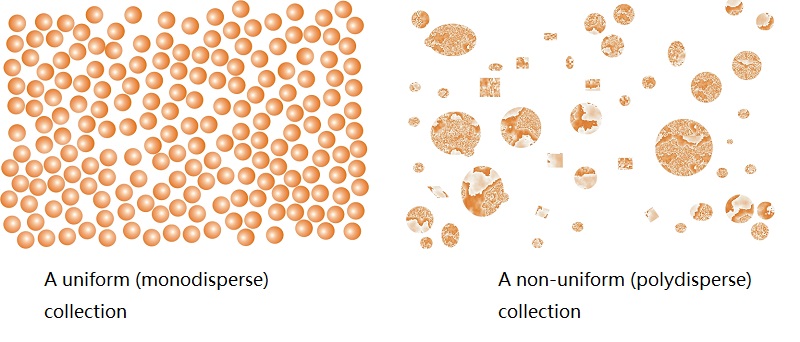Achieving Monodisperse Nanoparticles: Key to Precision in Nanotechnology
Definition: Monodispersity is a term used to describe a collection of particles, droplets, or molecules that have a uniform size, shape, or mass. In the context of nanotechnology, it refers to the degree to which nanoparticles are similar in size and shape. A monodisperse sample has minimal variation in these characteristics, making it crucial for applications requiring high precision and reproducibility.

Explanation and Importance
The concept of monodispersity is fundamental in materials science and nanotechnology. Uniformity in particle size and shape is essential because the physical, chemical, and biological properties of nanoparticles can vary significantly with small changes in these parameters. Monodisperse nanoparticles exhibit more predictable behaviors, improved stability, and higher efficiency in their applications, ranging from drug delivery systems to electronic devices.
Here are specific examples to illustrate the importance of monodispersity:
- Drug Delivery Systems. In drug delivery, precise control over nanoparticle size is crucial for targeting specific tissues and optimizing drug release rates. Enhanced Efficacy and Controlled Release: Monodisperse nanoparticles can be engineered to have precise surface properties and sizes, which is crucial for targeted drug delivery. For instance, nanoparticles designed to target cancer cells must be of a size that allows them to evade the body's immune system while efficiently accumulating in tumor tissues. Monodisperse nanoparticles with a size range of 50-100 nm have shown to preferentially accumulate in tumor tissues through the enhanced permeability and retention (EPR) effect, leading to improved treatment efficacy.
- Photonic Crystals. For photonic crystals, uniformity in particle size directly impacts their effectiveness in manipulating light. Uniform Optical Properties: Monodisperse nanoparticles can be assembled into photonic crystals that have uniform optical properties, which are essential for developing advanced optical materials. These materials can reflect light of specific wavelengths while transmitting others, making them useful for optical filters and sensors. The precise control over particle size in monodispersity ensures the photonic bandgap of these crystals is uniform, which is critical for their performance in applications such as fiber-optic networks and light-emitting devices.
- Quantum Dots. In optoelectronics, the consistency in the size of quantum dots is vital for ensuring uniform color emission in display technologies. Consistent Color Emission: In the field of optoelectronics, monodisperse quantum dots are used for their unique optical and electronic properties. The color of light emitted by quantum dots depends on their size; smaller dots emit blue light, while larger ones emit red light. Monodispersity ensures that all quantum dots in a sample emit light of the same color and intensity, which is crucial for their use in high-definition displays and LED lighting, where color uniformity and brightness are paramount.
- Catalysts. In catalysis, the effectiveness and selectivity of reactions often hinge on the uniformity of the catalyst particles. Improved Catalytic Activity and Selectivity: In catalysis, monodisperse nanoparticles can act as highly efficient catalysts due to their uniform surface area and active sites. For example, monodisperse palladium nanoparticles have been used in catalyzing Suzuki coupling reactions, a type of chemical reaction important in the synthesis of pharmaceuticals and fine chemicals. The uniformity in size ensures consistent catalytic activity and selectivity, leading to higher yields and lower by-products in these reactions.
- Nanoparticle Self-Assembly. The self-assembly of nanoparticles into ordered structures is a pathway to materials with new properties, necessitating uniform particle sizes. Predictable and Uniform Structures: The self-assembly of monodisperse nanoparticles into larger structures is a promising approach for creating materials with novel properties. For instance, the self-assembly of monodisperse magnetic nanoparticles can lead to materials with precisely controlled magnetic properties, useful in data storage and magnetic resonance imaging (MRI). The uniformity in particle size ensures that the assembled structures have consistent and predictable properties, essential for these high-tech applications.
These examples underscore the crucial role of monodispersity in advancing nanotechnology and its applications. By ensuring uniformity in nanoparticle size and shape, researchers and engineers can develop materials and devices with optimized and predictable performances, opening up new possibilities in science and technology.
Measuring Monodispersity
Monodispersity is typically quantified using techniques such as dynamic light scattering (DLS), transmission electron microscopy (TEM), and scanning electron microscopy (SEM). These methods provide information on the size distribution and shape of the nanoparticles, allowing researchers to assess the uniformity of a sample.
Challenges in Achieving Monodispersity
Achieving monodispersity in nanoparticle synthesis is challenging due to the complex dynamics of particle formation and growth. Factors such as the concentration of reactants, temperature, and stirring rate can influence the size and shape distribution of nanoparticles. Advanced synthesis techniques, including controlled precipitation and seed-mediated growth, have been developed to improve monodispersity.
Applications of Monodisperse Nanoparticles
Monodisperse nanoparticles have widespread applications in various fields:
- Medicine: For targeted drug delivery and imaging, where precise control over particle size can affect the distribution and clearance of nanoparticles in the body.
- Electronics: In the fabrication of devices with nanoscale features, where uniformity is critical for consistent electrical properties.
- Catalysis: Catalysts with uniform active sites can lead to more efficient and selective reactions, important for industrial processes.
- Optics: In the development of materials with specific optical properties, such as quantum dots, where size uniformity directly influences color emission.
The Significance of Monodispersity in Research and Industry
The pursuit of monodispersity underscores a fundamental goal in nanotechnology: to create materials with precise and predictable properties. This quest drives innovation in synthesis techniques and applications, impacting fields from healthcare to renewable energy. As understanding and technology advance, the ability to control nanoparticle uniformity will continue to play a critical role in the development of next-generation nanomaterials.
Further Reading
Annual Review of Materials Science, Synthesis and Characterization of Monodisperse Nanocrystals and Close-Packed Nanocrystal Assemblies
